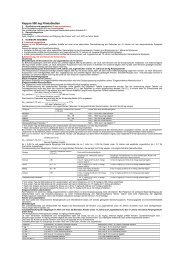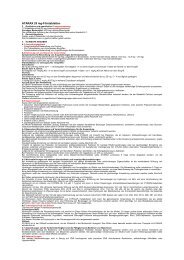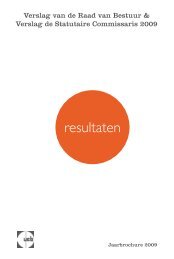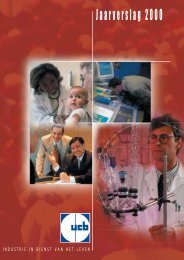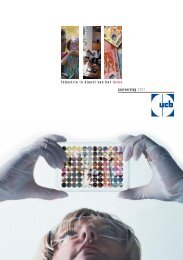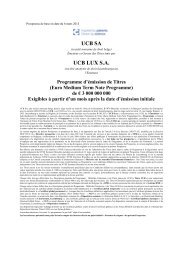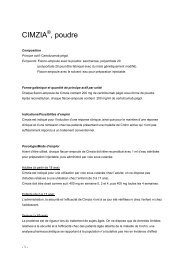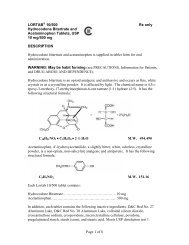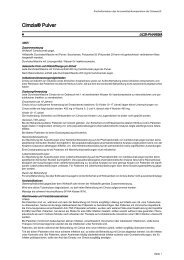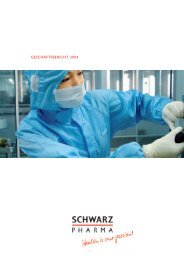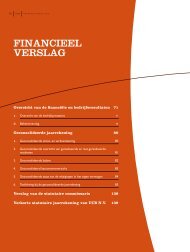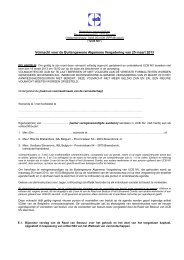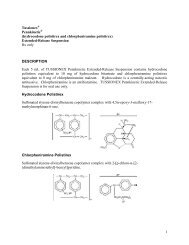UCB SA - BNP Paribas Fortis
UCB SA - BNP Paribas Fortis
UCB SA - BNP Paribas Fortis
Create successful ePaper yourself
Turn your PDF publications into a flip-book with our unique Google optimized e-Paper software.
supervision and control by various regulatory authorities and its production activities must comply with<br />
applicable health, safety and environmental regulations.<br />
Relevant regulations are typically of a national scope, although within the EU a considerable degree of<br />
harmonization exists. The EU institutions have created a common regulatory framework that applies in<br />
every EU member state (and that sometimes allows EU member states to adopt more detailed and more<br />
stringent regulations), and has indirect harmonizing effects in certain other European countries. Review<br />
and approval of certain products such as those generated at the Issuer is handled by the EMEA in a<br />
centralised procedure which, in the event of a positive outcome, results in approval for the product in all<br />
EU countries. In the United States such regulatory review is handled by the FDA.<br />
(a) Product approval<br />
Before the <strong>UCB</strong> Group can market pharmaceutical products in a particular country, it is required to<br />
obtain regulatory approval in accordance with the applicable national regulations. Following receipt of<br />
initial marketing approval, regulatory approval must be maintained in order to continue to market<br />
products. The regulatory requirements follow stringent standards that vary by country. From drug<br />
discovery through pre-clinical development and clinical trials to approval and initial product launch, the<br />
process of developing a pharmaceutical product is intensive, lengthy and rigorous, and takes<br />
approximately ten years. This period varies considerably depending on the targeted therapeutic area.<br />
Regulatory authorities have the right to link their approval to the implementation of stringent risk<br />
management measures for each drug which go beyond standard pharmacovigilance procedures. These<br />
measures may include additional clinical studies which can add substantially to the investment required<br />
to develop a new drug and to obtain and maintain its regulatory approval.<br />
Development of New Products<br />
Once a new compound has been identified in the laboratory as a potential candidate drug through a<br />
screening process, it undergoes broad pre-clinical testing. During pre-clinical testing, in-vitro tests and<br />
other studies in tissues and animals are conducted to show biological activity of the compound in<br />
models of the targeted disease, as well as to evaluate its potential toxicity. These steps are generally<br />
undertaken by <strong>UCB</strong> NewMedicines.<br />
To begin clinical trials (i.e., tests of the drug in humans) in the EU, applications have to be filed with the<br />
regulatory authorities of each member state in which clinical trials are intended to take place. To begin<br />
clinical trials in the United States, an investigational new drug (“IND”) application is filed with the<br />
FDA. The IND becomes effective if the FDA does not reject it within 30 days from its filing. In other<br />
countries there are varying but similar requirements before beginning clinical trials.<br />
Clinical testing prior to filing for a marketing license is usually done in three phases. This clinical<br />
development program can eventually be followed by a Phase IV study programme which is performed<br />
after marketing approval has been obtained. The size and the duration of clinical trials depend very<br />
much on the targeted disease. Typically, several hundred to several thousand patients have to be treated<br />
successfully under the highly controlled conditions of clinical trials before a sponsoring pharmaceutical<br />
company can apply for marketing authorisation. The duration of trials and the vast amount of data that<br />
must be collected and evaluated makes clinical testing the most time-consuming and expensive part of<br />
new drug development.<br />
Marketing Approval for New Products<br />
A11250830/2.25/23 Oct 2009 78



